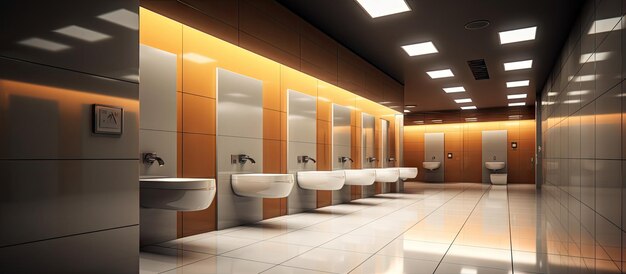In modern commercial spaces, the significance of well-designed toilet cubicles goes beyond basic functionality. Today’s washroom environments, particularly in offices, shopping malls, hotels, and schools, are often seen as reflections of the facility’s overall ambience and quality. High-quality toilet cubicles combine aesthetics, durability, privacy, and functionality to meet the evolving needs of users. In this guide, we’ll delve into the essentials of Toilet Cubicle Manufacturers‘ design, the various materials used, and the latest trends transforming washroom spaces.
Importance of Toilet Cubicle Design
Toilet cubicles play a crucial role in defining the overall experience of a washroom. A well-planned cubicle layout enhances flow, maximizes space utilization, and ensures user privacy and comfort. Moreover, these cubicles offer a cleaner, more organized environment and facilitate efficient cleaning and maintenance. The design of toilet cubicles also contributes significantly to a space’s aesthetics, impacting user perceptions.
Key Materials for Toilet Cubicles
The material of toilet cubicles influences their durability, maintenance requirements, cost, and appearance. Below are some popular materials used in toilet cubicle manufacturing:
- Compact Laminate (HPL): High-Pressure Laminate (HPL) is highly durable, resistant to scratches, moisture, and impact. HPL is ideal for high-traffic areas, such as schools and malls, and comes in a variety of colors and finishes for customization.
- Stainless Steel: Known for its sleek, modern look and unmatched durability, stainless steel is often used in luxury or high-end commercial spaces. It offers excellent resistance to vandalism, corrosion, and is very hygienic, making it a premium choice.
- Glass: For an elegant, upscale appearance, glass cubicles with frosted or tinted options are popular. While they provide a unique aesthetic appeal, glass cubicles need to be treated to ensure durability and safety.
- MDF or Plywood with Laminate Finish: These materials are cost-effective and offer a moderate level of durability. They’re typically used in low- to medium-traffic areas due to their susceptibility to moisture if not properly treated.
Types of Toilet Cubicle Configurations
Depending on the layout and specific needs of the washroom, toilet cubicles can be customized in various configurations. Some common configurations include:
- Standard Cubicles: Basic cubicles with doors and partitions for privacy.
- Accessible Cubicles: Designed to accommodate wheelchair access with features like wider doors, handrails, and sufficient maneuvering space.
- Urinal Privacy Screens: Smaller partitions between urinals to ensure privacy and hygiene.
- Changing Cubicles: Common in gyms and swimming pools, designed with additional space and features like seating or hooks.
Innovative Features in Modern Toilet Cubicles
As expectations rise, many toilet cubicles now come with innovative features to enhance user experience:
- Touchless Access: Doors with sensor-based access minimize touchpoints, improving hygiene.
- Occupancy Indicators: These are especially useful in high-traffic areas, allowing users to see which cubicles are vacant without disrupting other users.
- Integrated Lighting: LED lighting integrated into cubicle structures provides better visibility and a modern aesthetic.
Sustainability in Toilet Cubicle Design
Sustainability is an increasingly important factor in modern construction. Manufacturers are now offering eco-friendly cubicle options using sustainable materials and water-based finishes, and prioritizing low-emission manufacturing processes. Materials like recycled laminate or wood from certified sources are gaining traction as sustainable choices in toilet cubicle design.
Trends in Toilet Cubicle Aesthetics
Toilet cubicles are no longer limited to plain colors or standard finishes. Current trends lean toward personalized, visually pleasing designs that reflect the identity of the space:
- Vibrant Colors and Patterns: Bold colors and patterned laminates can enhance the look of a washroom and align with a brand’s identity.
- Natural Finishes: Wood-grain or stone finishes add a natural touch, often creating a warmer and more welcoming environment.
- Minimalistic Design: Sleek lines, frameless doors, and unobtrusive hardware give the space a modern, minimalistic feel.
- Curved and Rounded Cubicles: These designs add a soft touch and depart from traditional, rigid cubicle structures.
Maintenance and Hygiene Considerations
Maintaining hygiene in a high-traffic washroom is a priority. Here are a few maintenance tips to ensure longevity and cleanliness:
- Regular Cleaning: Choose materials that can withstand frequent cleaning with disinfectants and water.
- Anti-Graffiti and Scratch-Resistant Finishes: In public washrooms, these finishes can help maintain the cubicles’ appearance.
- Ventilation: Proper airflow is essential to avoid dampness, which can cause material degradation and odor buildup.
Choosing the Right Toilet Cubicle Manufacturer
When investing in toilet cubicles, working with a reputable manufacturer can make a significant difference. Look for manufacturers with experience in producing high-quality, durable cubicles and offering customization options. Additionally, check if they comply with safety standards and provide warranties on their products.
Conclusion
Toilet cubicles are integral to creating an efficient, attractive, and comfortable washroom experience. From selecting the right materials and configuration to incorporating modern trends and sustainable practices, each factor plays a role in creating a washroom that meets both functional and aesthetic standards. By understanding the essentials of toilet cubicle design, facility managers and designers can make informed choices that enhance the user experience and contribute positively to the overall ambiance of the facility.

